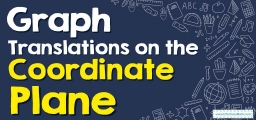Graph Points on a Coordinate Plane
This article gives you information about the coordinate plane and how to find points on it.

What’s a Coordinate Plane?
Coordinate planes are two-dimensional surfaces created using \(2\) number lines. It’s created whenever a horizontal line known as the \(X\)-axis as well as a vertical line known as a \(Y\)-axis intersect at a point known as the origin.
The numerals on a coordinate grid get utilized to find points. You can utilize a coordinate plane to graph points, lines, etc. It behaves like a map and produces accurate directions from one place to another.
Related Topics
What are Coordinates?
Coordinates are a collection of \(2\) values that find a precise spot on a coordinate plane grid, more well-known as a coordinate plane.
Points in coordinate planes are named via their ordered pair \((x, y)\), written inside parentheses, equivalent to the \(X\)-coordinate along with the \(Y\)-coordinate.
The coordinates could be positive, negative, or zero, dependent on the position of the point in the respective quadrant.
Quadrants on a Coordinate Plane
Quadrants can be described as an area/part of a cartesian or a coordinate plane achieved whenever the \(2\) axes intersect with each other.
- \(1^{st}\) quadrant: \(x > 0, y > 0\)
- \(2nd\) quadrant: \(x < 0, y > 0\)
- \(3rd\) quadrant: \(x < 0, y < 0\)
- \(4th\) quadrant: \(x > 0, y < 0\)
Finding a Point on a Coordinate Plane
Since we’re already acquainted with coordinate planes and their parts, now we can talk about the way to identify points on a coordinate plane. To find a point on a coordinate plane, follow the steps presented below:
- Step one: Find a point.
- Step two: Find a quadrant by looking at the signs of its \(X\) and \(Y\) coordinates.
- Step three: Find its \(X\)-coordinate or abscissa of the point via reading the number of units the point is to the right/left of the origin along its \(X\)-axis.
- Step four: Find its \(Y\)-coordinate or the ordinate of the point via reading the number of units the point is below/above the origin along its \(Y\)-axis.
Crucial Points on a Coordinate Plane:
- The \(1\)st quadrant \((+, +)\) called the positive coordinates quadrant is symbolized by the Roman numeral \(I\).
- The \(2\)nd quadrant \((-, +)\) is characterized by the Roman numeral \(II\).
- The \(3\)rd quadrant \((-, -)\) is characterized by the Roman numeral \(III\).
- The \(4\)th quadrant \((+, -)\) is characterized by the Roman numeral \(IV\).
- The coordinates of any point get put into brackets.
Graph Points on a Coordinate Plane – Example:
Plot each point on the coordinate grid.
\(A (1,5)\), \(B (3,3)\), \(C(4,3)\), \(D (5,2)\)
Solution:
First, we draw a coordinate axis so that the horizontal axis is the \(x\)-axis and the vertical axis is the \(y\)-axis. Each point with coordinates \((x, y)\) is defined on the axis so that \(x\) denotes the number of units the point is to the right/left of the origin along its \(x\)-axis and \(y\) denotes the number of units the point is below/above the origin along its \(y\)-axis. For example, to specify a point \((1, 5)\) from the origin of the coordinates, we must move one unit to the right and five units to the top.

Exercises for Graph Points on a Coordinate Plane
Plot each point on the coordinate grid.
- \(\color{blue}{A(5,3), B(1,8), C(7,2)}\)
- \(\color{blue}{A(7,4), B(6,1), C(4,2)}\)

1)

2)

Related to This Article
More math articles
- 6th Grade PSSA Math FREE Sample Practice Questions
- How to Decide Between the ACT and SAT?
- Cashing In on Math: How to Master the Addition of Money Amounts
- 10 Most Common 7th Grade FSA Math Questions
- Best Calculators for Linear Algebra and Calculus
- How to Solve Word Problems Involving the Percentage of a Number?
- Reading Clocks
- How to Find the Expected Value of a Random Variable?
- Decimals in Action: Completing Addition and Subtraction Sentences
- The Ultimate Praxis Core Math Formula Cheat Sheet



What people say about "Graph Points on a Coordinate Plane - Effortless Math: We Help Students Learn to LOVE Mathematics"?
No one replied yet.